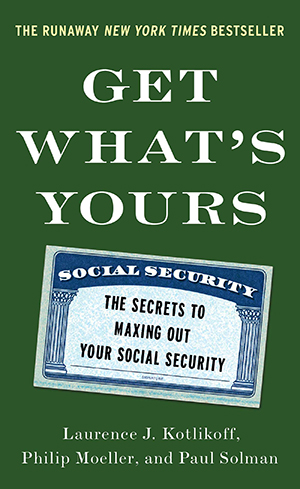Two numbers in BU economist Laurence Kotlikoff’s latest book add up to one big mess.
- Americans retiring every day: 10,000.
- Core rules in the Social Security system: 2,728.
Get What’s Yours: The Secrets to Maxing Out Your Social Security (Simon & Schuster, 2015), written with Philip Moeller, an expert on aging, and Paul Solman, PBS NewsHour economics correspondent, is intended to help retiring boomers make their way through that mess. People need the book, says Kotlikoff, a William Fairfield Warren Distinguished Professor and a College of Arts & Sciences professor of economics, because understanding the Social Security system isn’t easy.
Among much situation-specific advice, the book offers three big-picture tips for those hoping to maximize lifetime Social Security benefits: be patient, get all of what’s yours, and get the timing right.
Consider this: only 2 percent of Americans wait until the maximum age of 70, at which you must start collecting benefits, before they begin. Many Americans start collecting as soon as they can, generally at age 62, often because they have no other resources. But waiting until age 66, what Social Security calls “full retirement age,” can bump up their monthly benefit from, say, $750 to $1,000.
“One of the things we’re saying,” says Kotlikoff, “is that it’s optimal for a lot of people to wait until 70 to take their retirement benefit. Not everybody, but a lot of people.”
He says many people don’t even know that they have spousal and other benefits coming to them, or that they can collect only one benefit at a time. So a good strategy can be to have the higher-earning spouse file for his or her benefit at 62 and suspend it until age 70. The other can collect a spousal benefit before filing for his or her own benefit at 70.
“Once you start clicking on the rules, and the rules about the rules, and the rules about the rules about the rules, it’s endless,” Kotlikoff says. “And all of these rules about the rules are very, very important for people in specific situations.”
Started in the 1930s under the administration of Franklin Delano Roosevelt, Social Security is a collection of social insurance programs, funded by payroll taxes, that has become a primary source of income security for many Americans, mainly the retired, survivors of working spouses, and the disabled. As the book notes, “Toting up lifetime benefits, even low-earning couples may be Social Security millionaires.” On the other hand, the book warns, “The greatest danger you may face is outliving your savings.”
Readers will want to beware of “25 Bad-news gotchas that can reduce your benefits forever.” These include: “If you take two benefits at once, you lose one of the two,” “Only one spouse in a married couple can receive a spousal benefit by itself,” and “Remarry and potentially lose divorced spousal benefits potentially worth tens of thousands of dollars.”
Make one mistake, says Kotlikoff, and you can lose lots of money.
And then, of course, there’s this: “Social Security can change its rules.”
In February 2015, Kotlikoff came in at number 19 on The Economist magazine’s list of the world’s 25 most influential economists, along with high-profile names like Ben Bernanke (number 5) and Alan Greenspan (number 9). The author of 17 books and hundreds of articles, Kotlikoff has also published two software products, Maximize My Social Security and ESPlanner (Economic Security Planner).














































Related Stories
BU’s Kotlikoff One of Most Influential Economists
Economist honoree is pleased—and disbelieving
For Student Government’s First Black Woman President, Reform Continues
Hafzat Akanni (CAS’20) looks back, and ahead
BU Economist: Inequality Is Real, but Overstated
Kotlikoff’s latest research takes a different tack
Post Your Comment